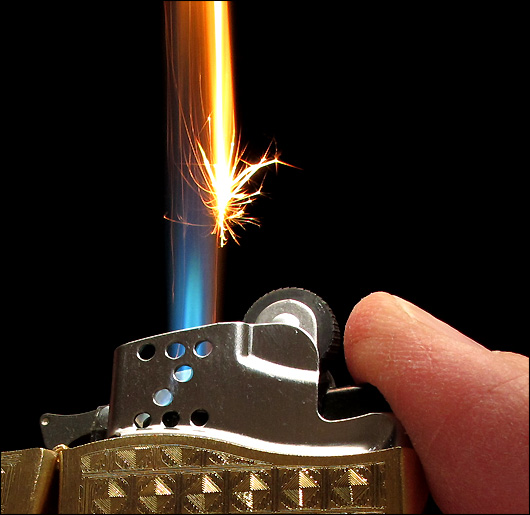 We, here in America, are pretty spoiled. Technology has made our lives progressively easier, and our tolerance for arduous tasks has diminished accordingly. No longer is a simple frying pan good enough…we now use machines that are specifically designed to cook our hamburgers, omelets, and grilled sandwiches faster and more easily than before.
We, here in America, are pretty spoiled. Technology has made our lives progressively easier, and our tolerance for arduous tasks has diminished accordingly. No longer is a simple frying pan good enough…we now use machines that are specifically designed to cook our hamburgers, omelets, and grilled sandwiches faster and more easily than before.
We cigar smokers have also benefited from this American lifestyle evolution. The stick match we used to light our cigars in the past has given way to the flint lighter that, in turn, has evolved into the butane torch. And in an effort to make lighting our cigars even more efficient, manufacturers have created multiple jet lighters. (Did they get their cue from the straight razor industry?!) We now have myriad designs and styles from which to choose, and, to a picky cigar smoker like myself, these choices are important. So, in the name of punctilious perfectionism, I hereby offer guidelines to finding The Perfect Cigar Lighter.
The Advantages of a Torch Lighter
For some of us, the old-school way of huffing and puffing to light a cigar is unappealing. It tends to “burnout” the palate, causing the first experiences of a cigar to be compromised. On the other hand, toasting the foot to the point of ignition allows the first puff to be as enjoyable as all the others. Plus, because the initial puffs are the most mild, it’s a good way to introduce the palate to the upcoming flavor profile of the cigar.
Anyone who has tried lighting a cigar with a match knows that a small wooden/paper stick, the size of a toothpick, is not an efficient method of ignition. Secondly, the Bic style lighter, although good for cigarettes, does not have the firepower to light a fat, moist, cylinder of tobacco. (Plus it’s pretty rough on the thumb.) Enter the torch lighter. Its blue, jet-like flame is hot enough to melt steel and has a laser like focus of heat that is good for concentrating the flame where it is needed. It is the perfect tool for lighting the foot of a cigar without the aid of puffing. But with the large diameter cigars that are so popular today, even a torch lighter may not be enough heat to get a cigar started. Enter the multiple jet torch lighter. Although overkill for some small ring size cigars, a double or even triple jet lighter can make quick work of a double robusto or salomon.
Flipping our lids
The thing that makes torch lighters great is also the thing that causes the biggest problem…heat. Lighters with metal flip-top caps can get so hot that touching them after use can cause one to burn the heck out of a finger. So, in the search for the perfect cigar lighter, we are led to pursuit no. 1: finding a lighter without a flip-top. This would not only avoid heat buildup at the cap, but also allow us to get as close to the cigar foot as we would like.
Getting closer to the cigar’s foot and using a smaller flame might even save fuel. (Man, this is getting REALLY picky, isn’t it?) That being said, it’s always a drag when the butane runs out.
Size matters
Have you ever returned to a great cigar after having put it down, only to find your lighter has run out of fuel? Bummer. Now you’ve got to fill it up, wait a few minutes for the fuel to warm, and then hope no air has been trapped in the tank (causing frustrating misfires). By now you’ve missed the end of a friends story, and your wife is wondering where you’ve been. With this in mind, pursuit no.2: a large fuel tank.
Perhaps in an effort to make cigar lighters small enough to be easily hand-held, many have tanks that are inadequate for maintaining an evenly lit cigar. It’s rare that a stick will burn perfectly down its entire length, and if you are a toucher-upper, maintaining the perfect burn requires a lot of fuel. Now the challenge is to find a torch lighter with a good flame and a tank large enough to keep it going. Not an easy task.
Blowin’ in the wind
So now we’ve found a lighter without a protruding cap, with a good flame and large fuel tank…now comes pursuit no.3: flame durability.
Many lighters, regardless of price have an Achilles heel: the flame can’t stand up to even the slightest breeze. Now granted, all cigars are hard to light in a breezy location, but it gets frustrating when we find a corner of a building for cover and still can’t get the cigar lit. This is where wind proofing is an advantage, and where one lighter’s feature can support another’s. By eliminating a flip-top cap, the flame’s nozzle needs to be recessed into the body of the lighter, otherwise, it will be vulnerable to damage or dirt accumulation. In this design, the body itself serves as a wind protector and, in some cases, offers better buffering than other lighters that claim to be wind-proof.
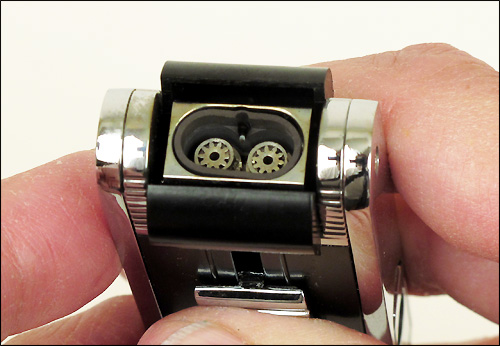
Recessed nozzels help block the wind.
Keeping the flame alive
When lighting a cigar there is nothing more frustrating than an unreliable flame. Clicking and clicking to produce a flame can get old, fast, and usually leads to switching lighters. The cause of this syndrome can be a clogged nozzle or poor quality fuel, but some lighters seem more vulnerable to unreliability than others. Even well maintained lighters can suffer from this malady and often end up in the junk drawer. And price seems to have little to do with it. Some of my most reliable lighters came free with cigar box purchases.
Thumb abuse
If anyone is as anal as I about toasting the foot of a cigar (probably no one is), you know that without a large valve trigger (button), lighting a cigar can be tough on the thumb. In order to be comfortable, the button needs to have a large surface area so as to not dig into our digit. So, this now becomes pursuit no.4: a large valve button.
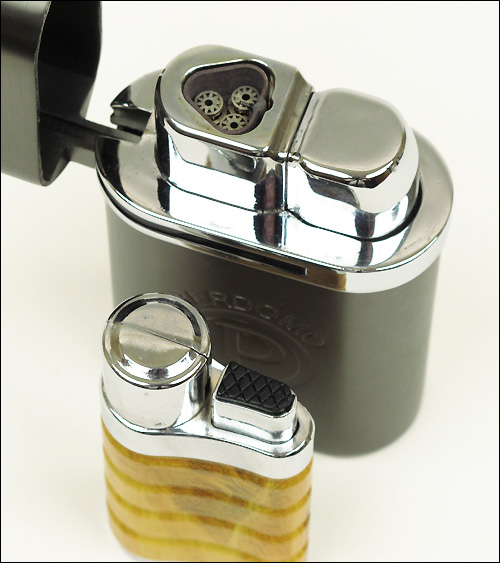
Skinny button (lower example) is less comfortable to use than a fat one (upper example).
De gustibus non est disputandum
My wife loves this expression. It’s Latin for “of taste there is no disputing”. Meaning that the lighter I like won’t necessarily be the one you like, so to bring appearance into this analysis would be an unnecessary distraction to the core elements of the perfect lighter.
Does the perfect lighter exist?
As far as I can tell, the answer is: not yet. Some lighters come close but all the lighters in this study have flaws. Each of us has a favorite lighter, one that meets our needs and feels good in our hand. But if I were going to market my own brand of cigar lighter it would have these attributes:
1) A singe jet torch with an option to ignite a second jet as needed.
2) A retractable cover that lays flat when in use.
3) A large fuel tank with a window to check the fuel level.
4) Recessed jets for wind protection.
5) Good flame reliability.
6) A large valve trigger positioned away from the heat of the ignited foot.
In conclusion
My quest for the perfect cigar lighter has led me through many different designs and as I look to the future, I hope manufactures will actually use their products to light cigars. I am finding that the current state of cigar lighters has not improved significantly over the years. We cigar smokers need a revolutionary lighter design to take this accessory up to the next level. Perhaps I’m being too picky, but a reliable lighter that doesn’t blow out or run out of fuel, stays lit, and doesn’t cramp my thumb, would be a welcome cigar lighting tool indeed.
Epilog
As the result of this article, I have become aware of an exceptional cigar lighter that has, at least for now, concluded my quest for the perfect cigar lighter (see Joe’s Gems). Although such a discovery might make this article moot, I am leaving it visible to illustrate the process that has led to my discovery.
Please note: This article was written with knowledge acquired first hand through personal experience. Dozens of lighters participated in this study and although not very scientific, it is the result of much empirical observation and is not offered as absolute fact.







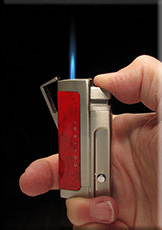
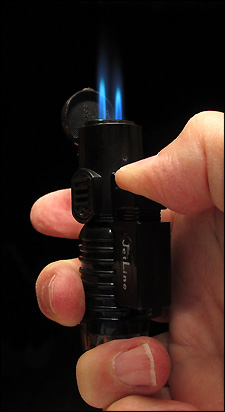

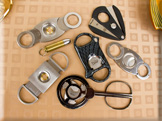

good read and Im with you 100 percent. this is all subject to outdoors Im assuming as indoors my preference is a quality match. call me old fashioned.. but I love to toast the foot and then use a match to finish the lighting ritual by taking just one or two puffs. getting that large flame from the cigar knowing that its lit completely. that’s my favorite way to light a cigar. usually I use three small wooden matches or one long match. cant beat it in my book. but as for jet lighters, and I havent bought a very expensive one yet, I cant seem to find that reliable one that will stand up to the wind, stay burning, has an easy thumb press and has a clear window to show you when you’ve filled it/emptied it correctly. now I dont use any tripled whatever fluids either. maybe I should. what you mentioned above woudl be the perfect torch lighter.
Joe,
Great piece. I only wish I had read some of the CA member’s comments about lighters before I purchased my $80 Colibri. I thought that it would be the last lighter I would have to buy. But, as many of the CA forum members must have heard, or experienced first-hand, the Colibri lighters are nothing but trouble. So, I apprecieate the effort you put into the research, and to write this piece. Based on your testimony alone, I’ve purchased the Maxilight. Even thought the site you bought if from is the best price I’ve found (other sites had the same lighter for $170), the $124 is more than I’d normally spend for a lighter. However, after spending $80 on the Colibri, of which after only 2 months, I’m frustrated with, I figure $124 for a lighter that should be the last one I need to buy, it a worth while investment.
Can you provide a few pointers on how to “keep good lighter performing like new?”
Thanks again.
Charlie I. (aka 8 0 1 1)
I picked up my best, most reliable lighter in Iraq at a local shop for $5. Don’t ask me how I got it home…
I have spent hundreds of $$ on torch lighters, and have gone back to a regular flame type. I too am a heavy foot toaster, and don’t find the need to “torch” the end of my smoke. I am lighting a cigar, not welding!
My current fav is a pipe lighter with an old fashion flint weel and butane gas. An old meets new idea that is very classy looking! The flame is pretty sturdy for not being a torch, and like I said, It looks good!
I also enjoy using a match when I am indoors. I is fun to watch old movies and show to see how cigars have been lighted in the past. Remmember alll of those old electric lighters? No gas, no smell, no problam s long as you could plug it in!
German cars come with “Cigar lighters” and may be worth trading up for. I have been stranded with out other means of fire and have become frustrated trying to light a cigar of decent girth with my American ciggerate lighter that came in my car! Great article! Enjoyed!
Very good artical. I would add adjustable flame.
also, I recieved an uncomfortable finger burn from a friends $80 lighter!